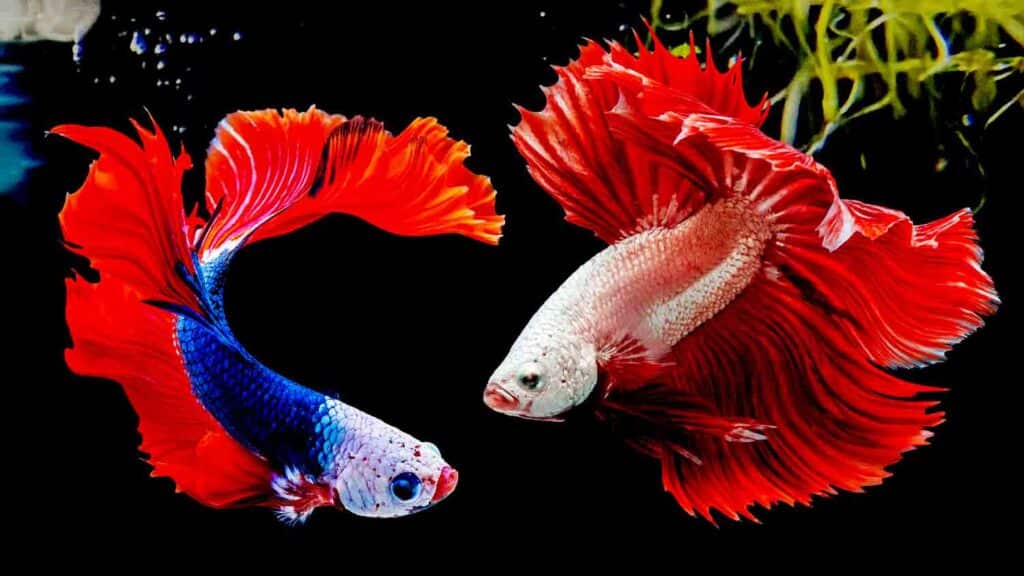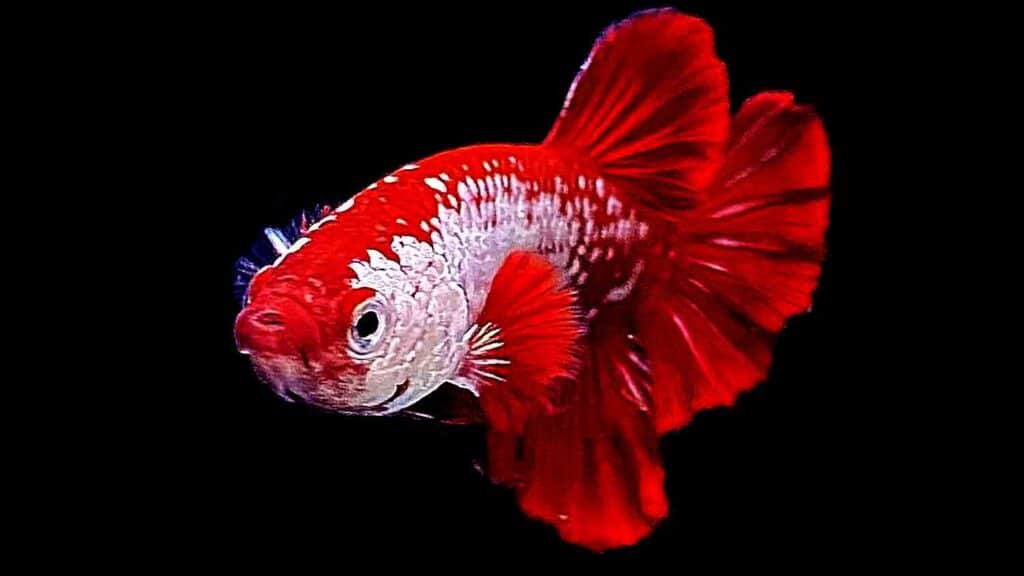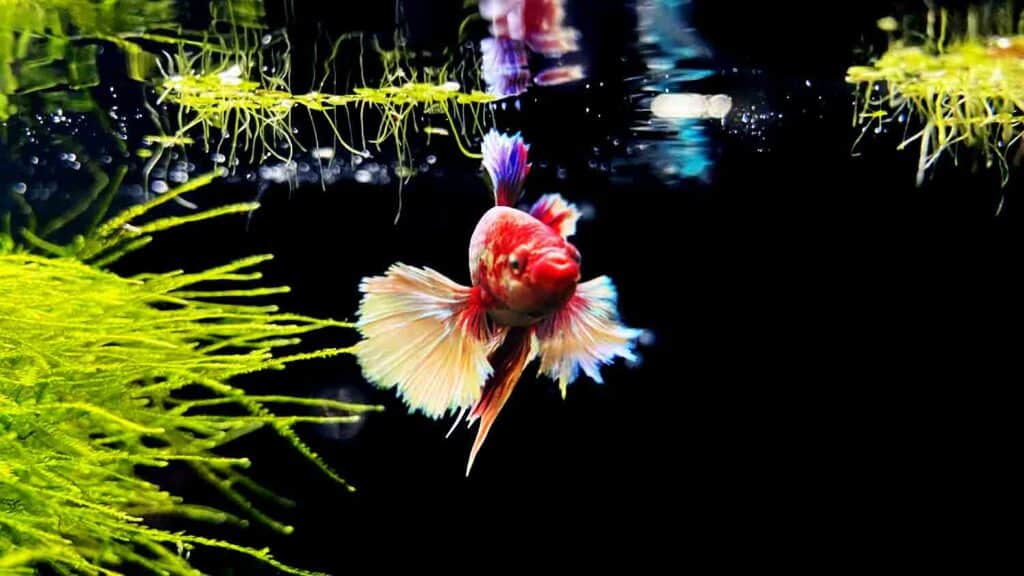The Betta Fish (Betta splendens) is one of the most beautiful ornamental fish in the world. These fish have developed to have beautiful coloration and the most unique flowing fins. Betta fish are also known as Siamese fighting fish or in short fighter fish. These beautiful fish are easy to care for and are a better alternative than goldfish to live in a bowl or vase. Tho we always recommend having them in an aquarium.
This guide will cover everything you need to know about betta fish and how to keep them happy and healthy for a long time. We will also share lots of tips and tricks to help you be a better betta owner.
Species Profile & Overview
Betta Fish are stunning fish originally from tropical regions of Thailand and Southeast Asia. They can be found in surrounding countries such as Malaysia, Vietnam, Indonesia, Cambodia, and Laos. That said, this fish is now being produced for the aquarium hobby by many breeders around the world.
These fish live in the shallow freshwater bodies of Thailand. They are often found in slow-moving streams, ponds, marshes, and rice paddies. Water in these areas is often too shallow that sometimes they can completely deplete. This is when locals find betta fish in tiny pits and puddles that have still waters. Bettas usually stay within these pits for days until another rain falls and water rises again.
Bettas, like all labyrinth fish, have a lung-like organ that lets them breathe air. This helps them live in small places where other fish can suffocate or die because of oxygen deficiency. This organ will also let them be more tolerant of poor water conditions in a short term.
These fish are super smart and with a little bit of work from you, they can learn a few tricks. These fish are highly food motivated and can learn tricks for a good treat.
Appearance & Types

The wild varieties of Betta splendens are coming in vivid coloration; However, the captive-bred ones are selectively bred to develop more intense rainbow colors. They come in all different colors and fin shapes. The captive-bred bettas are also selectively bred to develop long and flowing fins that the wild specimens lack.
These stunning fish are coming in bright red, blue, yellow, orange, pink, turquoise, and many more colors. The most beautiful specimens are the ones that have a mix of all or many colorations. Males are usually more colorful to attract females. Males tend to develop even deeper coloration during the mating season or when they are fighting over their territory.
As mentioned, wild specimens are usually less colorful and have shorter fins. With many years of selective breeding, breeders have now developed multiple different fin shapes for this fish. The most famous variations of them are crowntail, halfmoon, over halfmoon/super delta tail, dumbo/elephant ear, and Delta tail.
Betta fish are sexual dimorphism species and are available in pet stores in all different fin shapes and body colors. The shape of the fin and the rarity of their coloration is the usual way of pricing these fish. Males are often sold more expensively compared to less colorful females.
Adult Size
Betta fish grow to about 3 inches in length. This makes them great pet fish for any size aquarium. At the same time, their ability to live in smaller places makes them ideal fish for nano tanks.
Male and female bettas grow to about the same size but males develop larger fins which makes them look bigger.
Betta fish are fast-growing species and will become fully mature in just 7 months. Of course, this is just an estimation and there are many factors like genetics, temperature, water quality, diet, etc that can change their maturity time.
Lifespan
The lifespan of these beautiful fish really depends on the quality of water you place them in. A healthy Betta Fish can live about 2 – 5 years. When you keep them in perfect water conditions and provide them with a quality diet, you can expect them to easily reach 5 years of age.
That being said, the betta fish that are being kept in a fish bowl or vase are often experiencing sudden death and often die before reaching two years. This is because these fish need stable, clean, and warm waters to be able to live a long life. A fish bowl or vase usually lacks all the above-mentioned necessities for this fish.
Behavior and Temperament
Betta fish are naturally territorial species that will fight for their space. This is why they are known as Siamese fighting fish or Fighter Fish. Males are more aggressive than females and will instinctively fight with one another.
In the past, people of Thailand used to gamble by putting male betta fish to fight with each other. When two males are kept in a jar or bottle, they will almost immediately display aggressive behaviors.
Because of their aggressive territorial behaviors, you should never place two betta fish in a single tank. Males are also aggressive towards females and only accept females if they are in their breeding season.
Betta Fish Care
Betta Fish are super easy to care for. However, you will need to know the basics of fishkeeping to make them happy. With the right tank setup, water conditions, and diet, almost anyone can keep these beautiful creatures.
In this section, We will walk you through all the information you’ll need to give your fish the best possible life.

Tank Size
Betta Fish are small species and can live in tanks as small as 5 gallons. However, a larger aquarium can make your fish happier. We always recommend getting the largest tank you can and planting it with as many plants as you can. This makes your betta fish supper happy.
You might see some keep this fish in tiny fish bowls or even in cups in stores. This doesn’t mean they like to live in such a small space. It is also not healthy for a fish to live in such a small place. The only reason this fish can survive in such a small unhealthy place is due to its ability to breathe clean oxygen off the air.
If you haven’t yet purchased a bowl, we highly recommend getting a fully functioning small aquarium that can hold at least 5 gallons. You will thank us later!
What To Put In A Betta Tank
Betta fish are coming from densely planted warm areas in the wild. You will need to recreate their natural habitat for optimum health and lifespan. Fortunately, these fish are not picky when it comes to the type of plants and decorations you will want to place in their tank.
You can pick your favorite decorations to furnish your betta tank with. Just make sure all items you pick are aquarium safe and are not altering water chemistry in a negative way. Most artificial aquarium decorations are safe to use in a betta tank. But we recommend all-natural decorations.
Natural decorations are much more beautiful and are easier to create beautiful scenes. They can also help you with keeping the water parameters more stable. Natural aquarium rocks, live plants, and driftwood are among the best decorations for a betta tank.
Since betta tanks need to be heavily planted, we recommend choosing a soft-planted substrate for these fish. A good substrate will provide the life plants with all the nutrition they need to grow and develop healthy leaves. But you can also use other types of soft substrates like pebbles and sand.
Bettas are kinda lazy fish and they sometimes prefer to lay over plants or on the substrate. This is why you should have plants and a soft substrate where your fish can lay and relax. To learn more about what kind of plants are best for betta fish you can read Top 10 Betta Fish Plants.
Having live plants will make your tank look more beautiful and natural as well as keep the water clean for your fish. The waste your fish is producing will build up and can harm the fish if not removed by water change or plant. Plants will also make your betta feel more at home.
Water Parameters
Betta fish comes from the warm tropical waters of Southeast Asia. So recreating such an environment is crucial to keep them happy and healthy. These fish love to live in slightly warm water that is well-oxygenated.
Betta fish prefer to stay in their territory and do not like to swim around a lot. They prefer to stay in areas where the water is still and not moving so they don’t have to swim a lot. Having a slow-moving current in your tank is important to keep their stress levels down.
Below are the ideal tank parameters you can keep Betta fish in:
- Temperature: 75 – 80 Degrees Fahrenheit
- PH: 6.5 – 8.0
- TDS: 50 – 250 PPM
It is important to keep the heat up for these species. Ideally, you would want to keep the tank temperature at around 80º Fahrenheit. These fish will stop eating when kept in cooler waters which can cause all sorts of diseases in them.

Lighting
Betta fish prefer all-natural strong lighting. Because they live in well-planted areas, strong lighting will not harm them. When lights are on you will find your fish swimming in and under plants and enjoying their day. At the same time, your plants will need a strong source of light to be able to grow.
Most planted aquarium lights are an ideal type of light for Betta fish. The LED planted lights are often coming with blue light which brings out the true coloration of your fish. A full spectrum of light is good for your fish and the plants you are keeping.
Filter System
A properly filtered aquarium is essential to the long-term health and happiness of your betta fish. Having a filter that is able to handle the bioload of your fish is crucial to keep your tank healthy. You should think of a filter as an investment you make to prevent future losses. It will prevent your fish from becoming sick and even sudden death. Which will save you a lot of money, time, and stress.
An excellent filter is one that filters your tank biologically and mechanically. Most modern aquarium filters are capable of doing both. So you can safely purchase any filter you want. Just make sure your filter doesn’t have a strong pump that creates a lot of water flow in the tank. Bettas, as we mentioned earlier, love to be in still or slow-moving waters.
Common Betta Fish Diseases & Health Issues
Bettas are hardy fish but because many people keep them in tiny bowls and neglect them they tend to develop diseases. In a well-maintained aquarium that has water parameters in favor of bettas, these fish seem to not develop any of the common aquarium diseases.
That said, they are also susceptible to all diseases that might get introduced to your tank by other fish or plants. So it is important to know the common illness your betta fish are at risk of.
These beautiful fish have long and flowing fins that are at risk of getting fin rot. Fin rot is a bacterial infection that can get introduced to a tank by other fish or naturally develop because of waste buildup in a tank. Maintaining a clean tank will prevent this issue.
Lymphocystis and ich are also common among aquarium species. These diseases are external infections that your betta fish can get. These two diseases look very similar but Lymphocystis has a cauliflower-like growth on the skin; whereas White Spot Disease or “ich” results in white salt-like grains on the skin.
Bettas can also harm themselves if they have sharp objects in their tank. A small cut can easily get infected and threaten the life of your fish. So it is important to remove any sharp or rough object or decoration that you might have in their tank.
Diet and Feeding Requirements
These beautiful fish are not picky creatures when it comes to their diet but it is important to feed them quality foods. Betta fish are carnivore species and prefer to eat insect-based foods. However, they tend to eat most commercially made foods without any issues.
You can feed your bettas live or frozen foods like insect larvae, brine shrimp, microworms, bloodworm, ciliates, moina, etc. They should only receive a high-protein insect-based diet a few times per week. The rest of the time you can feed them commercially made dry foods.
Flakes and small pellets are one of the best foods for these fish. These fish can easily eat flakes or smaller pellets and it is very easy for you to feed them. Not all dry foods have the same ingredients so it’s important to make sure you are feeding your fish quality food.
Make sure to never overfeed your fish as the ruminating uneaten food will quickly rot and cause all kinds of health problems for your fish. Only feed a small amount that your fish can eat in a minute.
When keeping these fish in higher temperatures you might want to feed them a few times per day to keep them healthy and happy. Higher temperatures will cause the fish to burn more energy and as a result, it wants to eat more.
Breeding Betta Fish
Breeding betta fish is a little tricky. These fish are extremely territorial and will fight with any fish that comes close to their territory. This includes female betta fish as well. Males will only accept females when they are ready to mate.
To condition males to accept females for breeding, the females have to be in a separate tank next to the male’s tank where they can see each other. The female should be slightly smaller than the male so he doesn’t feel a threat from her. During this time, you should feed both fish high-protein food to trigger the breeding process.
The male’s tank should have stable water parameters and no substrate. A bare bottom tank is ideal as the male can easily find and pick the eggs once the breeding process begins. This will increase the survival rate of the eggs being laid. The water also should not be too high as it helps the male to pick the eggs quickly and put them up in the nested bubble.
Once the male is ready to breed it will start to create bubbles on the surface of the water. To help the bubbles to stay in place, it’s best to add a floating object to his tank. Surface floating plants or simply a piece of plastic bubble wrap can be great floating objects.
When you see the male has its bubble nest ready it’s time to add the female. It is best to add the female for a short amount of time and monitor their behavior. If the male shows signs of aggression and starts to pick on the female, you should remove the female and place it back in her own enclosure. You can repeat this process again in a day or two.
Once eggs are laid you can remove the female and let the male take care of the eggs.
You might need to do this entire process a few times before they actually lay eggs. So be patient and try again if your first few attempts are not successful.
Tank Mates
As you know by now, bettas are aggressive and territorial species. They often pick fights with any fish if they are living in a small tank. So if you have a small tank you should not try adding more fish of any kind to your tank. Some bettas seem to be more aggressive than others so it all depends on your luck if you want to try adding more fish to a betta tank.
However, if you have a large tank you can easily add more fish to your betta tank. Bettas are territorial and only get aggressive if other fish cross into their territory. The good thing is that they are tiny so is their territory. A large tank will provide all your fish enough space to live in harmony.
It is important to remember to not add betta fish with other aggressive fish, including other male bettas. You should only have one male betta in a single tank even if it’s a large tank. Larger fish might also bully bettas so only add similar-sized peaceful species.
It is best to keep fast swimming non-aggressive species with bettas. Fast swimming fish will swim swiftly if your betta fish wants to attack them and will also not harm your betta.
Considering all of these points, here are our top tank mates for your betta fish:
- Platy Fish
- Guppies
- Freshwater Snails
- Molly Fish
- Neon Tetra
- Pleco Fish
- Most Gouramis
- Amano Shrimp
- Bamboo Shrimp
- Vampire Shrimp

Conclusion
Betta fish are one of the most mistreated ornamental fish in the fishkeeping hobby. These fish can be great pet fish if you can provide them with a tank bigger than a fish bowl. They are smart and can learn a few tricks and will also recognize their owner. Their beautiful colors and large flowing fins made them one of the most beautiful fish in the world.
If you still have more questions about bettas, you can always reach out to us vis the contact us page. We already answered some of our readers questions in the Betta Questions & Answer article. You might find your answer there!
References:
Agonistic Behavior in Betta splendens
Dr. Krista Keller
Evolution, Culture, and Care for Betta splendens